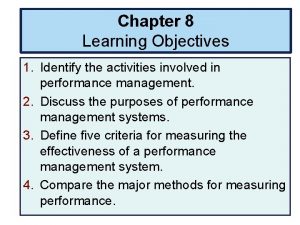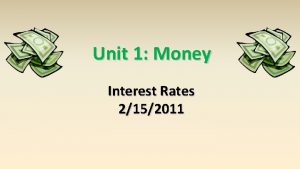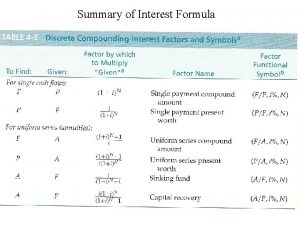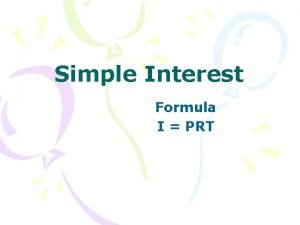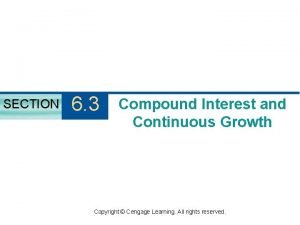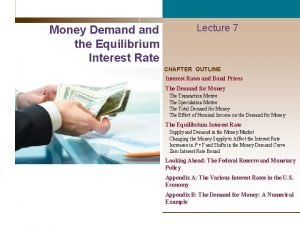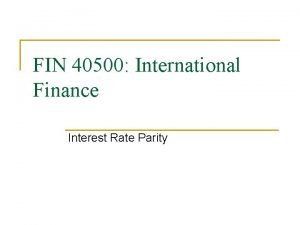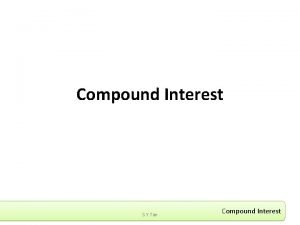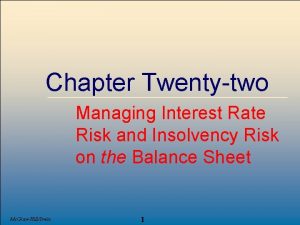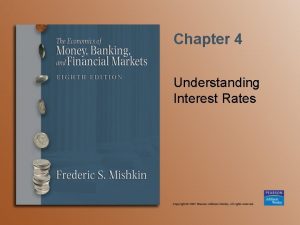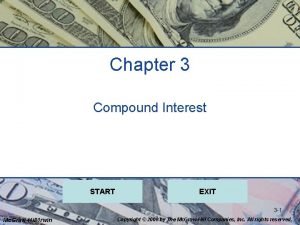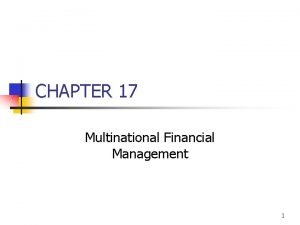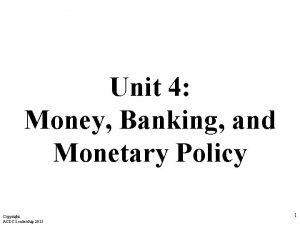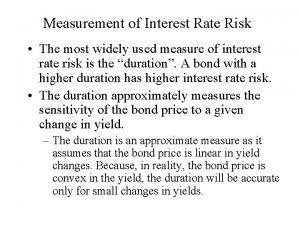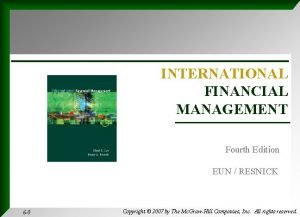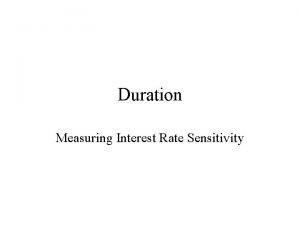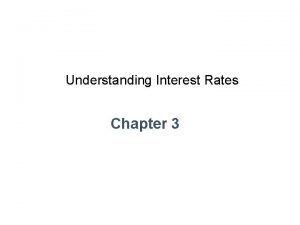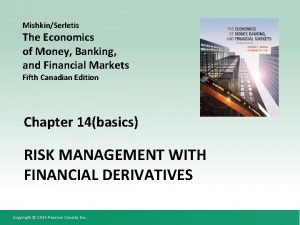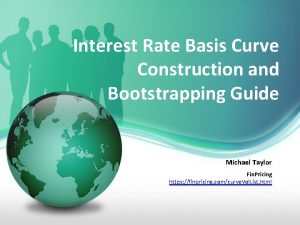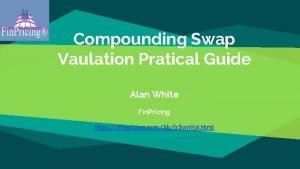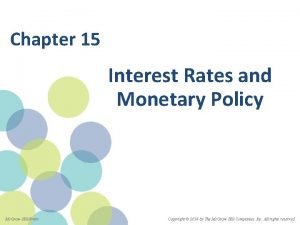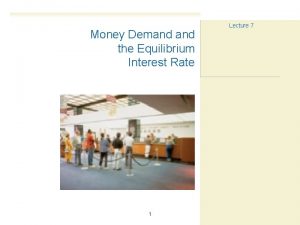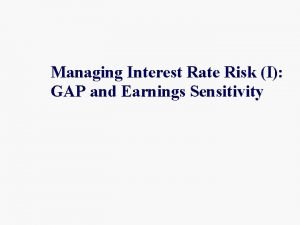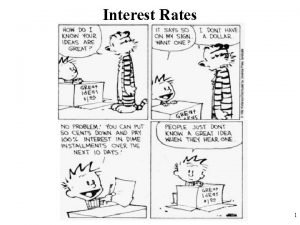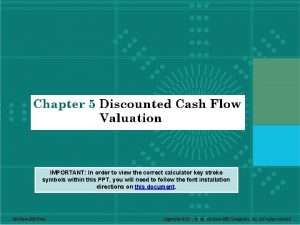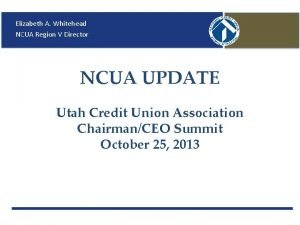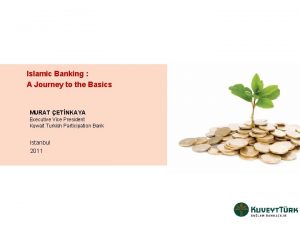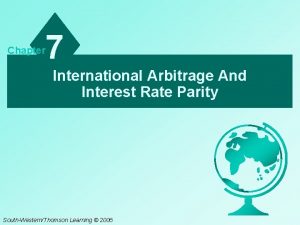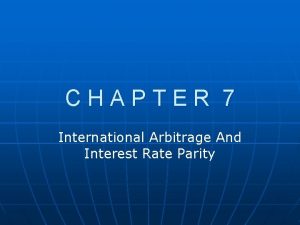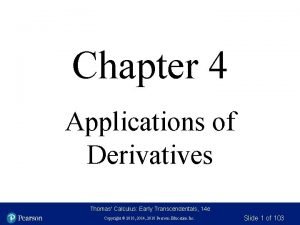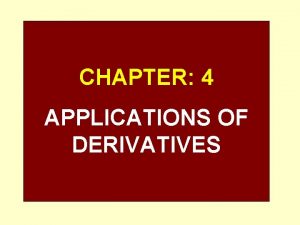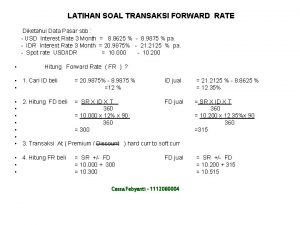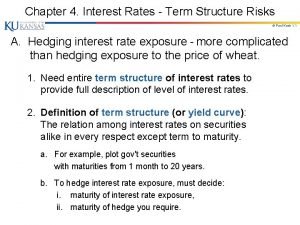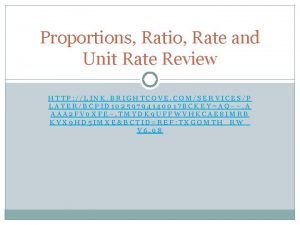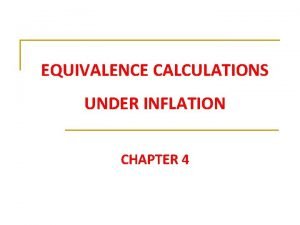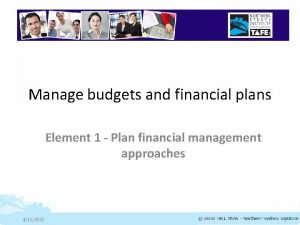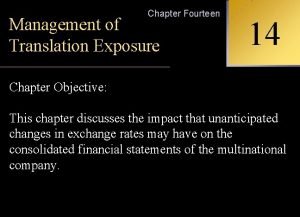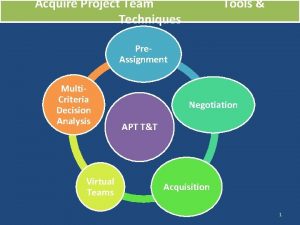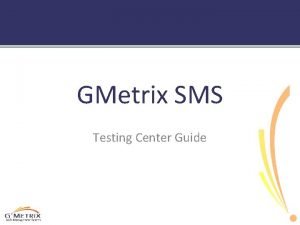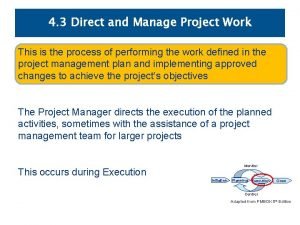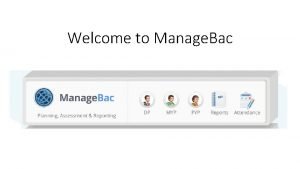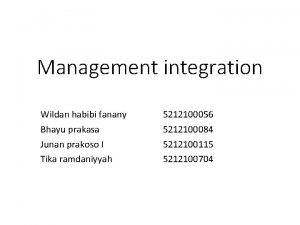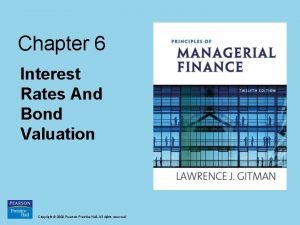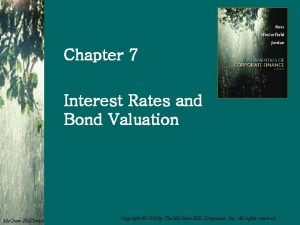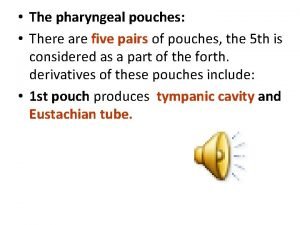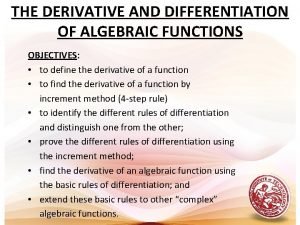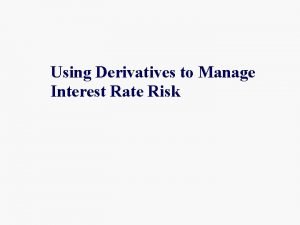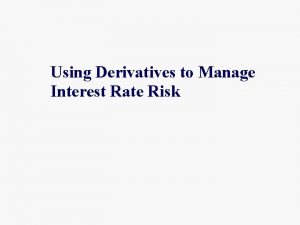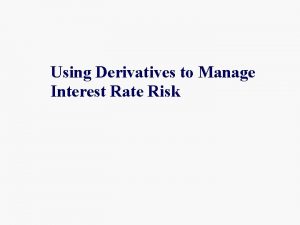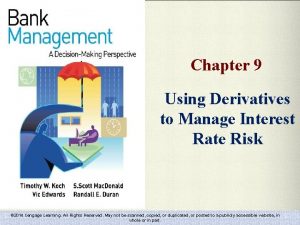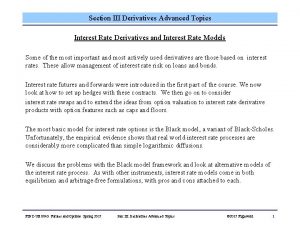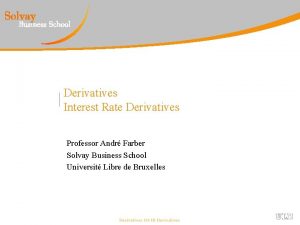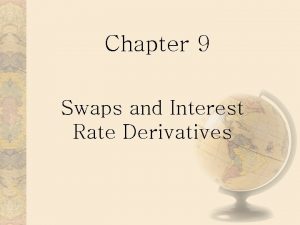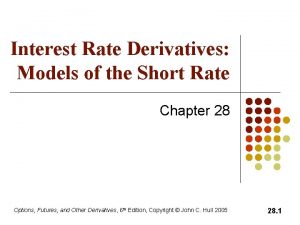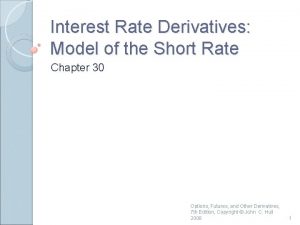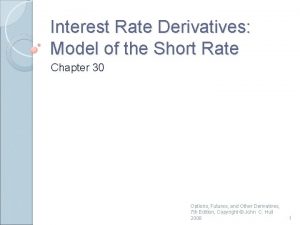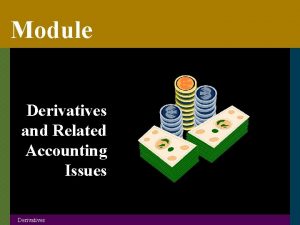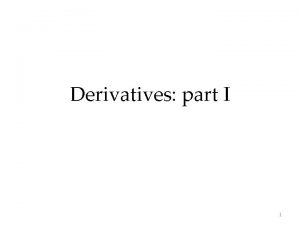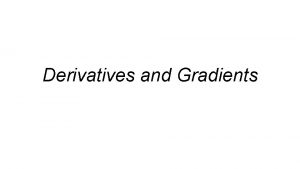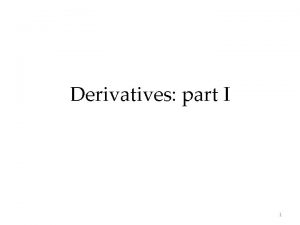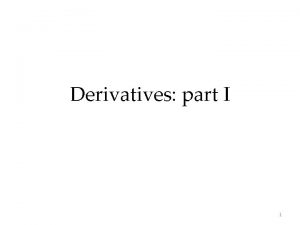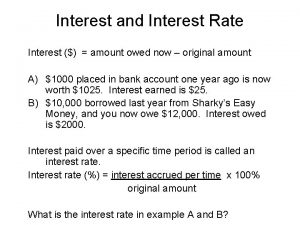Chapter 9 Using Derivatives to Manage Interest Rate

































































































































- Slides: 129

Chapter 9 Using Derivatives to Manage Interest Rate Risk © 2014 Cengage Learning. All Rights Reserved. May not be scanned, copied, or duplicated, or posted to a publicly accessible website, in whole or in part.

Using Derivatives to Manage Interest Rate Risk n Derivative n Any instrument or contract that derives its value from another underlying asset, instrument, or contract © 2014 Cengage Learning. All Rights Reserved. May not be scanned, copied, or duplicated, or posted to a publicly accessible website, in whole or in part. 2

Using Derivatives to Manage Interest Rate Risk n Derivatives Used to Manage Interest Rate Risk n Financial Futures Contracts n Forward Rate Agreements n Interest Rate Swaps n Options on Interest Rates Interest Rate Caps n Interest Rate Floors n © 2014 Cengage Learning. All Rights Reserved. May not be scanned, copied, or duplicated, or posted to a publicly accessible website, in whole or in part. 3

Characteristics of Financial Futures n Financial Futures Contracts n A commitment, between a buyer and a seller, on the quantity of a standardized financial asset or index n Futures Markets n The organized exchanges where futures contracts are traded n Interest Rate Futures n When the underlying asset is an interest-bearing security © 2014 Cengage Learning. All Rights Reserved. May not be scanned, copied, or duplicated, or posted to a publicly accessible website, in whole or in part. 4

Characteristics of Financial Futures n Buyers n A buyer of a futures contract is said to be long futures n Agrees to pay the underlying futures price or take delivery of the underlying asset n Buyers gain when futures prices rise and lose when futures prices fall © 2014 Cengage Learning. All Rights Reserved. May not be scanned, copied, or duplicated, or posted to a publicly accessible website, in whole or in part. 5

Characteristics of Financial Futures n Sellers n A seller of a futures contract is said to be short futures n Agrees to receive the underlying futures price or to deliver the underlying asset n Sellers gain when futures prices fall and lose when futures prices rise © 2014 Cengage Learning. All Rights Reserved. May not be scanned, copied, or duplicated, or posted to a publicly accessible website, in whole or in part. 6

Characteristics of Financial Futures n Cash or Spot Market n Market for any asset where the buyer tenders payment and takes possession of the asset when the price is set n Forward Contract n Contract for any asset where the buyer and seller agree on the asset’s price but defer the actual exchange until a specified future date © 2014 Cengage Learning. All Rights Reserved. May not be scanned, copied, or duplicated, or posted to a publicly accessible website, in whole or in part. 7

Characteristics of Financial Futures n Forward versus Futures Contracts n Traded on formal exchanges § Examples: Chicago Board of Trade and the Chicago Mercantile Exchange Involve standardized instruments n Positions require a daily marking to market n Positions require a deposit equivalent to a performance bond n © 2014 Cengage Learning. All Rights Reserved. May not be scanned, copied, or duplicated, or posted to a publicly accessible website, in whole or in part. 8

Characteristics of Financial Futures n Forward versus Futures Contracts n Forward contracts n Terms are negotiated between parties n Do not necessarily involve standardized assets n Require no cash exchange until expiration n No marking to market © 2014 Cengage Learning. All Rights Reserved. May not be scanned, copied, or duplicated, or posted to a publicly accessible website, in whole or in part. 9

Characteristics of Financial Futures n A Brief Example n Assume you want to invest $1 million in 10 -year T-bonds in six months and believe that rates will fall n You would like to “lock in” the 4. 5% 10 year yield prevailing today If such a contract existed, you would buy a futures contract on 10 -year T-bonds with an expiration date just after the six-month period n Assume that such a contract is priced at a 4. 45% rate n © 2014 Cengage Learning. All Rights Reserved. May not be scanned, copied, or duplicated, or posted to a publicly accessible website, in whole or in part. 10

Characteristics of Financial Futures n A Brief Example n If 10 -year Treasury rates actually fall sharply during the six months, the futures rate will similarly fall such that the futures price rises n An increase in the futures price generates a profit on the futures trade n You will eventually sell the futures contract to exit the trade © 2014 Cengage Learning. All Rights Reserved. May not be scanned, copied, or duplicated, or posted to a publicly accessible website, in whole or in part. 11

Characteristics of Financial Futures n A Brief Example n You will eventually sell the futures contract to exit the trade n Your effective yield will be determined by the prevailing 10 -year Treasury rate and the gain (or loss) on the futures trade n In this example, the decline in 10 -year rates will be offset by profits on the long futures position © 2014 Cengage Learning. All Rights Reserved. May not be scanned, copied, or duplicated, or posted to a publicly accessible website, in whole or in part. 12

Characteristics of Financial Futures n A Brief Example n The 10 -year Treasury rate falls by 0. 80%, which represents an opportunity loss n However, buying a futures contract generates a 0. 77% profit n The effective yield on the investment equals the prevailing 3. 70% rate at the time of investment plus the 0. 77% futures profit, or 4. 47% © 2014 Cengage Learning. All Rights Reserved. May not be scanned, copied, or duplicated, or posted to a publicly accessible website, in whole or in part. 13

Characteristics of Financial Futures n A Brief Example Loss from Treasury rate 4. 5%-3. 7% = 0. 8% Gain from future rate 4. 45%-3. 68% = 0. 77% Yield 3. 7%+0. 77% = 4. 47% © 2014 Cengage Learning. All Rights Reserved. May not be scanned, copied, or duplicated, or posted to a publicly accessible website, in whole or in part. 14

Characteristics of Financial Futures n Types of Future Traders n Commission Brokers n Execute trades for other parties n Locals n Trade for their own account n Locals are speculators © 2014 Cengage Learning. All Rights Reserved. May not be scanned, copied, or duplicated, or posted to a publicly accessible website, in whole or in part. 15

Characteristics of Financial Futures n Types of Future Traders n Speculator n Takes a position with the objective of making a profit n Tries to guess the direction that prices will move and time trades to sell (buy) at higher (lower) prices than the purchase price © 2014 Cengage Learning. All Rights Reserved. May not be scanned, copied, or duplicated, or posted to a publicly accessible website, in whole or in part. 16

Characteristics of Financial Futures n Types of Future Traders n Scalper n A speculator who tries to time price movements over very short time intervals and takes positions that remain outstanding for only minutes © 2014 Cengage Learning. All Rights Reserved. May not be scanned, copied, or duplicated, or posted to a publicly accessible website, in whole or in part. 17

Characteristics of Financial Futures n Types of Future Traders n Day Trader n Similar to a scalper but tries to profit from short-term price movements during the trading day; normally offsets the initial position before the market closes such that no position remains outstanding overnight © 2014 Cengage Learning. All Rights Reserved. May not be scanned, copied, or duplicated, or posted to a publicly accessible website, in whole or in part. 18

Characteristics of Financial Futures n Types of Future Traders n Position Trader n A speculator who holds a position for a longer period in anticipation of a more significant, longer-term market moves © 2014 Cengage Learning. All Rights Reserved. May not be scanned, copied, or duplicated, or posted to a publicly accessible website, in whole or in part. 19

Characteristics of Financial Futures n Types of Future Traders n Hedger n Has an existing or anticipated position in the cash market and trades futures contracts to reduce the risk associated with uncertain changes in the value of the cash position n Takes a position in the futures market whose value varies in the opposite direction as the value of the cash position when rates change n Risk is reduced because gains or losses on the futures position at least partially offset gains or losses on the cash position © 2014 Cengage Learning. All Rights Reserved. May not be scanned, copied, or duplicated, or posted to a publicly accessible website, in whole or in part. 20

Characteristics of Financial Futures n Types of Future Traders n Hedger versus Speculator n The essential difference between a speculator and hedger is the objective of the trader § A speculator wants to profit on trades § A hedger wants to reduce risk associated with a known or anticipated cash position © 2014 Cengage Learning. All Rights Reserved. May not be scanned, copied, or duplicated, or posted to a publicly accessible website, in whole or in part. 21

Characteristics of Financial Futures n Types of Future Traders n Spreader versus Arbitrageur n n Both are speculators that take relatively low-risk positions Futures Spreader May simultaneously buy a futures contract and sell a related futures contract trying to profit on anticipated movements in the price difference n The position is generally low risk because the prices of both contracts typically move in the same direction n © 2014 Cengage Learning. All Rights Reserved. May not be scanned, copied, or duplicated, or posted to a publicly accessible website, in whole or in part. 22

Characteristics of Financial Futures n Types of Future Traders n Arbitrageur Tries to profit by identifying the same asset that is being traded at two different prices in different markets at the same time n Buys the asset at the lower price and simultaneously sells it at the higher price n Arbitrage transactions are thus low risk and serve to bring prices back in line in the sense that the same asset should trade at the same price in all markets n © 2014 Cengage Learning. All Rights Reserved. May not be scanned, copied, or duplicated, or posted to a publicly accessible website, in whole or in part. 23

Characteristics of Financial Futures n The Mechanics of Futures Trading n Initial Margin n A cash deposit (or U. S. government securities) with the exchange simply for initiating a transaction n Initial margins are relatively low, often involving less than 5% of the underlying asset’s value © 2014 Cengage Learning. All Rights Reserved. May not be scanned, copied, or duplicated, or posted to a publicly accessible website, in whole or in part. 24

Characteristics of Financial Futures n The Mechanics of Futures Trading n Maintenance Margin n The minimum deposit required at the end of each day § Unlike margin accounts for stocks, futures margin deposits represent a guarantee that a trader will be able to make any mandatory payment obligations © 2014 Cengage Learning. All Rights Reserved. May not be scanned, copied, or duplicated, or posted to a publicly accessible website, in whole or in part. 25

Characteristics of Financial Futures n The Mechanics of Futures Trading n Marking-to-Market n The daily settlement process where at the end of every trading day, a trader’s margin account is: § Credited with any gains § Debited with any losses n Variation n Margin The daily change in the value of margin account due to marking-to-market © 2014 Cengage Learning. All Rights Reserved. May not be scanned, copied, or duplicated, or posted to a publicly accessible website, in whole or in part. 26

Characteristics of Financial Futures n The Mechanics of Futures Trading n Expiration Date Every futures contract has a formal expiration date n On the expiration date, trading stops and participants settle their final positions n Less than 1% of financial futures contracts experience physical delivery at expiration because most traders offset their futures positions in advance n © 2014 Cengage Learning. All Rights Reserved. May not be scanned, copied, or duplicated, or posted to a publicly accessible website, in whole or in part. 27

Characteristics of Financial Futures n An Example: 90 -Day Eurodollar Time Deposit Futures The underlying asset is a Eurodollar time deposit with a 3 -month maturity n Eurodollar rates are quoted on an interest -bearing basis, assuming a 360 -day year n Each Eurodollar futures contract represents $1 million of initial face value of Eurodollar deposits maturing three months after contract expiration n © 2014 Cengage Learning. All Rights Reserved. May not be scanned, copied, or duplicated, or posted to a publicly accessible website, in whole or in part. 28

Characteristics of Financial Futures n An Example: 90 -Day Eurodollar Time Deposit Futures n Contracts n trade according to an index: 100 – Futures Price = Futures Rate § An index of 94. 50 indicates a futures rate of 5. 5% § Each basis point change in the futures rate equals a $25 change in value of the contract (0. 001 x $1 million x 90/360) © 2014 Cengage Learning. All Rights Reserved. May not be scanned, copied, or duplicated, or posted to a publicly accessible website, in whole or in part. 29

Characteristics of Financial Futures n An Example: 90 -Day Eurodollar Time Deposit Futures n Over forty separate contracts are traded at any point in time, as contracts expire in March, June, September and December each year Buyers make a profit when futures rates fall (prices rise) n Sellers make a profit when futures rates rise (prices fall) n (100 -future price= future rate) n © 2014 Cengage Learning. All Rights Reserved. May not be scanned, copied, or duplicated, or posted to a publicly accessible website, in whole or in part. 30

Characteristics of Financial Futures n Daily Marking-To-Market n Consider a trader trading on June 6, 2008 who buys one December 2008 threemonth Eurodollar futures contract at $96. 98 posting $1, 100 in cash as initial margin n Maintenance margin is set at $700 per contract n The futures contract expires approximately six months after the initial purchase, during which time the futures price and rate fluctuate daily n © 2014 Cengage Learning. All Rights Reserved. May not be scanned, copied, or duplicated, or posted to a publicly accessible website, in whole or in part. 31

Characteristics of Financial Futures n Daily Marking-To-Market n Suppose that on June 13 the futures rate falls from 3. 02% to 2. 92% n The trader could withdraw $250 n (250 = 10 basis points × $25) n from the margin account, n representing the increase in value of the position © 2014 Cengage Learning. All Rights Reserved. May not be scanned, copied, or duplicated, or posted to a publicly accessible website, in whole or in part. 32

Characteristics of Financial Futures n Daily Marking-To-Market n If the futures rate increases to 3. 08% the next day, the trader’s long position decreases in value n The 16 basis-point increase n represents a $400 = 16 x $25 drop in margin n the ending account balance would equal $950 © 2014 Cengage Learning. All Rights Reserved. May not be scanned, copied, or duplicated, or posted to a publicly accessible website, in whole or in part. 33

Characteristics of Financial Futures n Daily Marking-To-Market n If the futures rate increases further to 3. 23%, the trader must make a variation margin payment sufficient to bring the account up to $700 n the account balance would have fallen to $575 n the margin contribution would equal $125 n The exchange member may close the account if the trader does not meet the variation margin requirement n © 2014 Cengage Learning. All Rights Reserved. May not be scanned, copied, or duplicated, or posted to a publicly accessible website, in whole or in part. 34

Future price Future rate Rate 0. 01 100 96. 98 3. 02 100 97. 08 2. 92 fall 100 96. 92 3. 08 100 96. 77 3. 23 0. 1 bsp 1 bsp $25 Initial margin Mainte nance 1100 700 10 250 1350 rise -0. 16 -400 950 rise -0. 15 -375 575 -125 © 2014 Cengage Learning. All Rights Reserved. May not be scanned, copied, or duplicated, or posted to a publicly accessible website, in whole or in part. 35

Characteristics of Financial Futures n Daily Marking-To-Market n The Basis n Basis = Cash Price – Futures Price § or n Basis = Futures Rate – Cash Rate § It may be positive or negative, depending on whether futures rates are above or below spot rates § May swing widely in value far in advance of contract expiration © 2014 Cengage Learning. All Rights Reserved. May not be scanned, copied, or duplicated, or posted to a publicly accessible website, in whole or in part. 36

Characteristics of Financial Futures © 2014 Cengage Learning. All Rights Reserved. May not be scanned, copied, or duplicated, or posted to a publicly accessible website, in whole or in part. 37

Speculation versus Hedging n Speculators Take On Risk To Earn Speculative Profits Speculation is extremely risky n Example n n You believe interest rates will fall, so you buy Eurodollar futures § If rates fall, the price of the underlying Eurodollar rises, and thus the futures contract value rises earning you a profit § If rates rise, the price of the Eurodollar futures contract falls in value, resulting in a loss © 2014 Cengage Learning. All Rights Reserved. May not be scanned, copied, or duplicated, or posted to a publicly accessible website, in whole or in part. 38

Speculation versus Hedging n Hedgers Take Positions to Avoid or Reduce Risk n. A hedger already has a position in the cash market and uses futures to adjust the risk of being in the cash market n The focus is on reducing or avoiding risk © 2014 Cengage Learning. All Rights Reserved. May not be scanned, copied, or duplicated, or posted to a publicly accessible website, in whole or in part. 39

Speculation versus Hedging n Hedgers Take Positions to Avoid or Reduce Risk n Example A bank anticipates needing to borrow $1, 000 in 60 days. n The bank is concerned that rates will rise in the next 60 days n A possible strategy would be to short Eurodollar futures. n If interest rates rise (fall), the short futures position will increase (decrease) in value. This will (partially) offset the increase (decrease) in borrowing costs n © 2014 Cengage Learning. All Rights Reserved. May not be scanned, copied, or duplicated, or posted to a publicly accessible website, in whole or in part. 40

© 2014 Cengage Learning. All Rights Reserved. May not be scanned, copied, or duplicated, or posted to a publicly accessible website, in whole or in part. 41

Speculation versus Hedging n Steps in Hedging 1. Identify the cash market risk exposure to reduce 2. Given the cash market risk, determine whether a long or short futures position is needed 3. Select the best futures contract 4. Determine the appropriate number of futures contracts to trade © 2014 Cengage Learning. All Rights Reserved. May not be scanned, copied, or duplicated, or posted to a publicly accessible website, in whole or in part. 42

Speculation versus Hedging n Steps in Hedging 5. Buy or sell the appropriate futures contracts 6. Determine when to get out of the hedge position, either by reversing the trades, letting contracts expire, or making or taking delivery 7. Verify that futures trading meets regulatory requirements and the banks internal risk policies © 2014 Cengage Learning. All Rights Reserved. May not be scanned, copied, or duplicated, or posted to a publicly accessible website, in whole or in part. 43

Speculation versus Hedging n A Long Hedge: Reduce Risk Associated With A Decrease In Interest Rates n A long hedge (buy futures) is appropriate for a participant who wants to reduce spot market risk associated with a decline in interest rates If spot rates decline, futures rates will typically also decline so that the value of the futures position will likely increase. n Any loss in the cash market is at least partially offset by a gain in futures n © 2014 Cengage Learning. All Rights Reserved. May not be scanned, copied, or duplicated, or posted to a publicly accessible website, in whole or in part. 44

Speculation versus Hedging n A Long Hedge: Reduce Risk Associated With A Decrease In Interest Rates n On June 6, 2008, your bank expects to receive a $1 million payment on November 28, 2008, and anticipates investing the funds in three-month Eurodollar time deposits n n n The cash market risk exposure is that the bank would like to invest the funds at today’s rates, but will not have access to the funds for over five months In June 2008, the market expected Eurodollar rates to increase as evidenced by rising futures rates. © 2014 Cengage Learning. All Rights Reserved. May not be scanned, copied, or duplicated, or posted to a publicly accessible website, in whole or in part. 45

Speculation versus Hedging n A Long Hedge: Reduce Risk Associated With A Decrease In Interest Rates n In order to hedge, the bank should buy futures contracts The best futures contract will generally be the first contract that expires after the known cash transaction date. n This contract is best because its futures price will generally show the highest correlation with the cash price n § In this example, the December 2008 Eurodollar futures contract is the first to expire after November 2008 © 2014 Cengage Learning. All Rights Reserved. May not be scanned, copied, or duplicated, or posted to a publicly accessible website, in whole or in part. 46

Speculation versus Hedging n A Long Hedge: Reduce Risk Associated With A Decrease In Interest Rates n The time line of the bank’s hedging activities: © 2014 Cengage Learning. All Rights Reserved. May not be scanned, copied, or duplicated, or posted to a publicly accessible website, in whole or in part. 47

Speculation versus Hedging © 2014 Cengage Learning. All Rights Reserved. May not be scanned, copied, or duplicated, or posted to a publicly accessible website, in whole or in part. 48

Speculation versus Hedging n A Short Hedge: Reduce Risk Associated With A Increase In Interest Rates A short hedge (sell futures) is appropriate for a participant who wants to reduce spot market risk associated with an increase in interest rates n If spot rates increase, futures rates will typically also increase so that the value of the futures position will likely decrease. n Any loss in the cash market is at least partially offset by a gain in the futures market n © 2014 Cengage Learning. All Rights Reserved. May not be scanned, copied, or duplicated, or posted to a publicly accessible website, in whole or in part. 49

Speculation versus Hedging n A Short Hedge: Reduce Risk Associated With A Increase In Interest Rates n On June 6, 2008, your bank expects to sell a six-month $1 million Eurodollar deposit on August 17, 2008 The cash market risk exposure is that interest rates may rise and the value of the Eurodollar deposit will fall by August 2008 n In order to hedge, the bank should sell futures contracts n © 2014 Cengage Learning. All Rights Reserved. May not be scanned, copied, or duplicated, or posted to a publicly accessible website, in whole or in part. 50

Speculation versus Hedging n A Short Hedge: Reduce Risk Associated With A Increase In Interest Rates n In order to hedge, the bank should sell futures contracts n In this example, the September 2008 Eurodollar futures contract is the first to expire after September 17, 2008 © 2014 Cengage Learning. All Rights Reserved. May not be scanned, copied, or duplicated, or posted to a publicly accessible website, in whole or in part. 51

Speculation versus Hedging n A Short Hedge: Reduce Risk Associated With A Increase In Interest Rates n The time line of the bank’s hedging activities: © 2014 Cengage Learning. All Rights Reserved. May not be scanned, copied, or duplicated, or posted to a publicly accessible website, in whole or in part. 52

Speculation versus Hedging © 2014 Cengage Learning. All Rights Reserved. May not be scanned, copied, or duplicated, or posted to a publicly accessible website, in whole or in part. 53

Speculation versus Hedging n Change in the Basis n Long and short hedges work well if the futures rate moves in line with the spot rate n The actual risk assumed by a trader in both hedges is that n the basis might change between the time the hedge is initiated and closed © 2014 Cengage Learning. All Rights Reserved. May not be scanned, copied, or duplicated, or posted to a publicly accessible website, in whole or in part. 54

Speculation versus Hedging n Change in the Basis n Effective Return = Initial Cash Rate – Change in Basis = Initial Cash Rate – (B 2 – B 1) where : B 1 is the basis when the hedge is opened B 2 is the basis when the hedge is closed © 2014 Cengage Learning. All Rights Reserved. May not be scanned, copied, or duplicated, or posted to a publicly accessible website, in whole or in part. 55

Speculation versus Hedging n Change in the Basis n Effective Return: Long Hedge = Initial Cash Rate – (B 2 – B 1) = 2. 68% - (0. 10% - 0. 34%) = 2. 92% n Effective Return: Short Hedge = Initial Cash Rate – (B 2 – B 1) = 3. 00% - (0. 14% - -0. 17%) = 2. 69% © 2014 Cengage Learning. All Rights Reserved. May not be scanned, copied, or duplicated, or posted to a publicly accessible website, in whole or in part. 56

Speculation versus Hedging n Basis Risk and Cross Hedging n Cross Hedge n Where a trader uses a futures contract based on one security that differs from the security being hedged in the cash market © 2014 Cengage Learning. All Rights Reserved. May not be scanned, copied, or duplicated, or posted to a publicly accessible website, in whole or in part. 57

Speculation versus Hedging n Basis Risk and Cross Hedging n Cross Hedge n Example § Using Eurodollar futures to hedge changes in the commercial paper rate n Basis risk increases with a cross hedge because the futures and spot interest rates may not move closely together © 2014 Cengage Learning. All Rights Reserved. May not be scanned, copied, or duplicated, or posted to a publicly accessible website, in whole or in part. 58

Microhedging Applications n Microhedge n The hedging of a transaction associated with a specific asset, liability or commitment n Macrohedge n Taking futures positions to reduce aggregate portfolio interest rate risk © 2014 Cengage Learning. All Rights Reserved. May not be scanned, copied, or duplicated, or posted to a publicly accessible website, in whole or in part. 59

Microhedging Applications n Banks are generally restricted in their use of financial futures for hedging purposes Banks must recognize futures on a micro basis by linking each futures transaction with a specific cash instrument or commitment n Some feel that such micro linkages force microhedges that may potentially increase a firm’s total risk because these hedges ignore all other portfolio components n © 2014 Cengage Learning. All Rights Reserved. May not be scanned, copied, or duplicated, or posted to a publicly accessible website, in whole or in part. 60

Microhedging Applications n The Mechanics of Applying a Microhedge 1. 2. 3. Determine the bank’s interest rate position Forecast the dollar flows or value expected in cash market transactions Choose the appropriate futures contract © 2014 Cengage Learning. All Rights Reserved. May not be scanned, copied, or duplicated, or posted to a publicly accessible website, in whole or in part. 61

Microhedging Applications n The Mechanics of Applying a Microhedge 4. Determine the correct number of futures contracts n Where § § NF = number of futures contracts A = Dollar value of cash flow to be hedged F = Face value of futures contract Mc = Maturity or duration of anticipated cash asset or liability § Mf = Maturity or duration of futures contract § © 2014 Cengage Learning. All Rights Reserved. May not be scanned, copied, or duplicated, or posted to a publicly accessible website, in whole or in part. 62

Microhedging Applications n The Mechanics of Applying a Microhedge 5. 6. Determine the Appropriate Time Frame for the Hedge Monitor Hedge Performance © 2014 Cengage Learning. All Rights Reserved. May not be scanned, copied, or duplicated, or posted to a publicly accessible website, in whole or in part. 63

Macrohedging Applications n Macrohedging n Focuses on reducing interest rate risk associated with a bank’s entire portfolio rather than with individual transactions © 2014 Cengage Learning. All Rights Reserved. May not be scanned, copied, or duplicated, or posted to a publicly accessible website, in whole or in part. 64

Macrohedging Applications n Hedging: GAP or Earnings Sensitivity n If a bank loses when interest rates fall (the bank has a positive GAP), it should use a long hedge n If rates rise, the bank’s higher net interest income will be offset by losses on the futures position n If rates fall, the bank’s lower net interest income will be offset by gains on the futures position © 2014 Cengage Learning. All Rights Reserved. May not be scanned, copied, or duplicated, or posted to a publicly accessible website, in whole or in part. 65

Macrohedging Applications n Hedging: GAP or Earnings Sensitivity n If a bank loses when interest rates rise (the bank has a negative GAP), it should use a short hedge n If rates rise, the bank’s lower net interest income will be offset by gains on the futures position n If rates fall, the bank’s higher net interest income will be offset by losses on the futures position © 2014 Cengage Learning. All Rights Reserved. May not be scanned, copied, or duplicated, or posted to a publicly accessible website, in whole or in part. 66

Macrohedging Applications n Hedging: Duration GAP and EVE Sensitivity n To eliminate interest rate risk, a bank could structure its portfolio so that its duration gap equals zero © 2014 Cengage Learning. All Rights Reserved. May not be scanned, copied, or duplicated, or posted to a publicly accessible website, in whole or in part. 67

Macrohedging Applications n Hedging: Duration GAP and EVE Sensitivity n Futures can be used to adjust the bank’s duration gap n The appropriate size of a futures position can be determined by solving the following equation for the market value of futures contracts (MVF), where DF is the duration of the futures contract © 2014 Cengage Learning. All Rights Reserved. May not be scanned, copied, or duplicated, or posted to a publicly accessible website, in whole or in part. 68

Macrohedging Applications n Hedging: Duration GAP and EVE Sensitivity n Example: With a positive duration gap, n the EVE will decline if interest rates rise n © 2014 Cengage Learning. All Rights Reserved. May not be scanned, copied, or duplicated, or posted to a publicly accessible website, in whole or in part. 69

Macrohedging Applications n Hedging: Duration GAP and EVE Sensitivity n Example: n The bank needs to sell interest rate futures contracts in order to hedge its risk position § The short position indicates that the bank will make a profit if futures rates increase © 2014 Cengage Learning. All Rights Reserved. May not be scanned, copied, or duplicated, or posted to a publicly accessible website, in whole or in part. 70

Macrohedging Applications n Hedging: Duration GAP and EVE Sensitivity n Example: n If the bank uses a Eurodollar futures contract currently trading at 4. 9% with a duration of 0. 25 years, the target market value of futures contracts (MVF) is: § MVF = $4, 096. 82, § so the bank should sell four Eurodollar futures contracts © 2014 Cengage Learning. All Rights Reserved. May not be scanned, copied, or duplicated, or posted to a publicly accessible website, in whole or in part. 71

Macrohedging Applications n Accounting Requirements and Tax Implications n Regulators generally limit a bank’s use of futures for hedging purposes n If a bank has a dealer operation, it can use futures as part of its trading activities § In such accounts, gains and losses on these futures must be marked-to-market, thereby affecting current income n Microhedging § To qualify as a hedge, a bank must show that a cash transaction exposes it to interest rate risk, a futures contract must lower the bank’s risk exposure, and the bank must designate the contract as a hedge © 2014 Cengage Learning. All Rights Reserved. May not be scanned, copied, or duplicated, or posted to a publicly accessible website, in whole or in part. 72

Using Forward Rate Agreements to Manage Rate Risk n Forward Rate Agreements n A forward contract based on interest rates based on a notional principal amount at a specified future date n Similar to futures but differ in that they: § Are negotiated between parties § Do not necessarily involve standardized assets § Require no cash exchange until expiration (i. e. there is no marking-to-market) § No exchange guarantees performance © 2014 Cengage Learning. All Rights Reserved. May not be scanned, copied, or duplicated, or posted to a publicly accessible website, in whole or in part. 73

Using Forward Rate Agreements to Manage Rate Risk n Notional Principal n Serves as a reference figure in determining cash flows for the two counterparties to a forward rate agreement agree n “Notional” refers to the condition that the principal does not change hands, but is only used to calculate the value of interest payments © 2014 Cengage Learning. All Rights Reserved. May not be scanned, copied, or duplicated, or posted to a publicly accessible website, in whole or in part. 74

Using Forward Rate Agreements to Manage Rate Risk n Buyer n Agrees to pay a fixed-rate coupon payment and receive a floating-rate payment against the notional principal at some specified future date © 2014 Cengage Learning. All Rights Reserved. May not be scanned, copied, or duplicated, or posted to a publicly accessible website, in whole or in part. 75

Using Forward Rate Agreements to Manage Rate Risk n Seller n Agrees to pay a floating-rate payment and receive the fixed-rate payment against the same notional principal n The buyer and seller will receive or pay cash when the actual interest rate at settlement is different than the exercise rate © 2014 Cengage Learning. All Rights Reserved. May not be scanned, copied, or duplicated, or posted to a publicly accessible website, in whole or in part. 76

Using Forward Rate Agreements to Manage Rate Risk n Forward Rate Agreements: An Example n Suppose that Metro Bank (as the seller) enters into a receive fixed-rate/pay floating-rating forward rate agreement with County Bank (as the buyer) with a six -month maturity based on a $1 million notional principal amount n The floating rate is the 3 -month LIBOR and the fixed (exercise) rate is 5% © 2014 Cengage Learning. All Rights Reserved. May not be scanned, copied, or duplicated, or posted to a publicly accessible website, in whole or in part. 77

Using Forward Rate Agreements to Manage Rate Risk n Forward Rate Agreements: An Example n Metro Bank would refer to this as a n “ 3 vs. 6” FRA at 5% on a $1 million notional amount from County Bank n The only cash flow will be determined in six months at contract maturity by comparing the prevailing 3 -month LIBOR with 5% © 2014 Cengage Learning. All Rights Reserved. May not be scanned, copied, or duplicated, or posted to a publicly accessible website, in whole or in part. 78

Using Forward Rate Agreements to Manage Rate Risk n Forward Rate Agreements: An Example n Assume that in three months 3 -month LIBOR equals 6% n In this case, Metro Bank would receive from County Bank $2, 463 § The interest settlement amount is $2, 500: § Interest = (. 06 -. 05)(90/360) $1, 000 = $2, 500 § Because this represents interest that would be paid three months later at maturity of the instrument, the actual payment is discounted at the prevailing 3 -month LIBOR § Actual interest = $2, 500/[1+(90/360). 06]=$2, 463 © 2014 Cengage Learning. All Rights Reserved. May not be scanned, copied, or duplicated, or posted to a publicly accessible website, in whole or in part. 79

LIBOR 6% in 3 -months Metro Bank Seller Pay LIBOR 6% Receive Fixed rate. 5% County Bank Buyer Receive LIBOR 6% Pay Fixed rate 5% Country bank pays to Metro Interest = (. 06 -. 05)(90/360) $1, 000 = $2, 500 Actual interest = $2, 500/[1+(90/360). 06]=$2, 463 * $1 million notional principal amount © 2014 Cengage Learning. All Rights Reserved. May not be scanned, copied, or duplicated, or posted to a publicly accessible website, in whole or in part. 80

Using Forward Rate Agreements to Manage Rate Risk n Forward Rate Agreements: An Example n If instead, LIBOR equals 3% in three months, Metro Bank would pay County Bank: n The interest settlement amount is $5, 000 § Interest = (. 05 -. 03)(90/360) $1, 000 = $5, 000 § Actual interest = $5, 000 /[1 + (90/360). 03] = $4, 963 © 2014 Cengage Learning. All Rights Reserved. May not be scanned, copied, or duplicated, or posted to a publicly accessible website, in whole or in part. 81

LIBOR 3% in 3 -months Metro Bank Seller Pay LIBOR 3% Receive Fixed rate. 5% County Bank Buyer Receive LIBOR 3% Pay Fixed rate 5% Metro bank pays to County Interest = (. 05 -. 03)(90/360) $1, 000 = $5, 000 Actual interest = $5, 000 /[1 + (90/360). 03] = $4, 963 * $1 million notional principal amount © 2014 Cengage Learning. All Rights Reserved. May not be scanned, copied, or duplicated, or posted to a publicly accessible website, in whole or in part. 82

Using Forward Rate Agreements to Manage Rate Risk n Forward Rate Agreements: An Example n County Bank would pay fixed-rate/receive floating-rate as a hedge if it was exposed to loss in a rising rate environment n n This is analogous to a short futures position Metro Bank would sell fixed-rate/receive floating-rate as a hedge if it was exposed to loss in a falling rate environment. n This is analogous to a long futures position © 2014 Cengage Learning. All Rights Reserved. May not be scanned, copied, or duplicated, or posted to a publicly accessible website, in whole or in part. 83

Using Forward Rate Agreements to Manage Rate Risk n Potential Problems with FRAs n There is no clearinghouse to guarantee, so you might not be paid when the counterparty owes you cash n It is sometimes difficult to find a specific counterparty that wants to take exactly the opposite position n FRAs are not as liquid as many alternatives © 2014 Cengage Learning. All Rights Reserved. May not be scanned, copied, or duplicated, or posted to a publicly accessible website, in whole or in part. 84

Basic Interest Rate Swaps as a Risk Management Tool n Characteristics n Basic (Plain Vanilla) Interest Rate Swap n An agreement between two parties to exchange a series of cash flows based on a specified notional principal amount n Two parties facing different types of interest rate risk can exchange interest payments © 2014 Cengage Learning. All Rights Reserved. May not be scanned, copied, or duplicated, or posted to a publicly accessible website, in whole or in part. 85

Basic Interest Rate Swaps as a Risk Management Tool n Characteristics n Basic (Plain Vanilla) Interest Rate Swap n One party makes payments based on a fixed interest rate and receives floating rate payments n The other party exchanges floating rate payments for fixed-rate payments n When interest rates change, the party that benefits from a swap receives a net cash payment while the party that loses makes a net cash payment © 2014 Cengage Learning. All Rights Reserved. May not be scanned, copied, or duplicated, or posted to a publicly accessible website, in whole or in part. 86

Basic Interest Rate Swaps as a Risk Management Tool n Characteristics n Basic (Plain Vanilla) Interest Rate Swap n Conceptually, a basic interest rate swap is a package of FRAs n As with FRAs, swap payments are netted and the notional principal never changes hands © 2014 Cengage Learning. All Rights Reserved. May not be scanned, copied, or duplicated, or posted to a publicly accessible website, in whole or in part. 87

Basic Interest Rate Swaps as a Risk Management Tool n Characteristics n Plain Vanilla Example n Using data for a 2 -year swap based on 3 month LIBOR as the floating rate § This swap involves eight quarterly payments. Party FIX agrees to pay a fixed rate n Party FLT agrees to receive a fixed rate with cash flows calculated against a $10 million notional principal amount n © 2014 Cengage Learning. All Rights Reserved. May not be scanned, copied, or duplicated, or posted to a publicly accessible website, in whole or in part. 88

Basic Interest Rate Swaps as a Risk Management Tool n Characteristics n Plan Vanilla Example © 2014 Cengage Learning. All Rights Reserved. May not be scanned, copied, or duplicated, or posted to a publicly accessible website, in whole or in part. 89

© 2014 Cengage Learning. All Rights Reserved. May not be scanned, copied, or duplicated, or posted to a publicly accessible website, in whole or in part. 90

Basic Interest Rate Swaps as a Risk Management Tool n Characteristics n Plain Vanilla Example n If the three-month LIBOR for the first pricing interval equals 3% § The fixed payment for Party FIX is $83, 770 and the floating rate receipt is $67, 744 § Party FIX will have to pay the difference of $16, 026 § The floating-rate payment for Party FLT is $67, 744 and the fixed-rate receipt is$83, 520 § Party FLT will receive the difference of $15, 776 § The dealer will net $250 from the spread ($16, 026 -$15, 776) © 2014 Cengage Learning. All Rights Reserved. May not be scanned, copied, or duplicated, or posted to a publicly accessible website, in whole or in part. 91

Basic Interest Rate Swaps as a Risk Management Tool n Characteristics n Plain Vanilla Example n At the second and subsequent pricing intervals, only the applicable LIBOR is unknown § As LIBOR changes, the amount that both Party FIX and Party FLT either pay or receive will change § Party FIX will only receive cash at any pricing interval if three-month LIBOR exceeds 3. 36% § Party FLT will similarly receive cash as long as three-month LIBOR is less than 3. 35% © 2014 Cengage Learning. All Rights Reserved. May not be scanned, copied, or duplicated, or posted to a publicly accessible website, in whole or in part. 92

Basic Interest Rate Swaps as a Risk Management Tool n Characteristics n Convert a Floating-Rate Liability to a Fixed Rate Liability § Consider a bank that makes a $1 million, three-year fixed-rate loan with quarterly interest at 8% § It finances the loan by issuing a threemonth Eurodollar deposit priced at threemonth LIBOR © 2014 Cengage Learning. All Rights Reserved. May not be scanned, copied, or duplicated, or posted to a publicly accessible website, in whole or in part. 93

Basic Interest Rate Swaps as a Risk Management Tool n Characteristics n Convert a Floating-Rate Liability to a Fixed Rate Liability n By itself, this transaction exhibits considerable interest rate § The bank is liability sensitive and loses (gains) if LIBOR rises (falls) n The bank can use a basic swap to microhedge this transaction § Using the data from Exhibit 9. 8, the bank could agree to pay 3. 72% and receive three-month LIBOR against $1 million for the three years § By doing this, the bank locks in a borrowing cost of 3. 72% because it will both receive and pay LIBOR every quarter © 2014 Cengage Learning. All Rights Reserved. May not be scanned, copied, or duplicated, or posted to a publicly accessible website, in whole or in part. 94

Basic Interest Rate Swaps as a Risk Management Tool n Characteristics n Convert a Floating-Rate Liability to a Fixed Rate Liability n The use of the swap enables the bank to reduce risk and lock in a spread of 4. 28 percent (8. 00 percent − 3. 72 percent) on this transaction while effectively fixing the borrowing cost at 3. 72 percent for three years © 2014 Cengage Learning. All Rights Reserved. May not be scanned, copied, or duplicated, or posted to a publicly accessible website, in whole or in part. 95

Basic Interest Rate Swaps as a Risk Management Tool n Characteristics n Convert a Fixed-Rate Asset to a Floating. Rate Asset n Consider a bank that has a customer who demands a fixed-rate loan § The bank has a policy of making only floatingrate loans because it is liability sensitive and will lose if interest rates rise § Ideally, the bank wants to price the loan based on prime n Now assume that the bank makes the same $1 million, three-year fixed-rate loan as in the “Convert a Floating-Rate Liability to a Fixed Rate Liability” example © 2014 Cengage Learning. All Rights Reserved. May not be scanned, copied, or duplicated, or posted to a publicly accessible website, in whole or in part. 96

Basic Interest Rate Swaps as a Risk Management Tool n Characteristics n Convert a Fixed-Rate Asset to a Floating. Rate Asset n The bank could enter into a swap, agreeing to pay a 3. 7% fixed rate and receive prime minus 2. 40% with quarterly payments § This effectively converts the fixed-rate loan into a variable rate loan that floats with the prime rate © 2014 Cengage Learning. All Rights Reserved. May not be scanned, copied, or duplicated, or posted to a publicly accessible website, in whole or in part. 97

Basic Interest Rate Swaps as a Risk Management Tool n Characteristics n Create a Synthetic Hedge n Some view basic interest rate swaps as synthetic securities § As such, they enter into a swap contract that essentially replicates the net cash flows from a balance sheet transaction § Suppose a bank buys a three-year Treasury yielding 2. 73%, which it finances by issuing a three-month deposit § As an alternative, the bank could enter into a three-month swap agreeing to pay threemonth LIBOR and receive a fixed rate © 2014 Cengage Learning. All Rights Reserved. May not be scanned, copied, or duplicated, or posted to a publicly accessible website, in whole or in part. 98

Basic Interest Rate Swaps as a Risk Management Tool n Characteristics n Macrohedge n Banks can also use interest rate swaps to hedge their aggregate risk exposure measured by earnings and EVE sensitivity § A bank that is liability sensitive or has a positive duration gap will take a basic swap position that potentially produces profits when rates increase § With a basic swap, this means paying a fixed rate and receiving a floating rate § Any profits can be used to offset losses from lost net interest income or declining © 2014 Cengage Learning. All Rights Reserved. May not be scanned, copied, or duplicated, or posted to a publicly accessible website, in whole or in part. 99

Basic Interest Rate Swaps as a Risk Management Tool n Characteristics n Macrohedge n In terms of GAP analysis, a liabilitysensitive bank has more rate-sensitive liabilities than rate-sensitive assets § To hedge, the bank needs the equivalent of more RSAs § A swap that pays fixed and receives floating is comparable to increasing RSAs relative to RSLs because the receipt reprices with rate changes © 2014 Cengage Learning. All Rights Reserved. May not be scanned, copied, or duplicated, or posted to a publicly accessible website, in whole or in part. 100

Basic Interest Rate Swaps as a Risk Management Tool n Pricing Basic Swaps n The floating rate is based on some predetermined money market rate or index n n The payment frequency is coincidentally set at every six months, three months, or one month, and is generally matched with the money market rate The fixed rate is set at a spread above the comparable maturity fixed rate security © 2014 Cengage Learning. All Rights Reserved. May not be scanned, copied, or duplicated, or posted to a publicly accessible website, in whole or in part. 101

Basic Interest Rate Swaps as a Risk Management Tool n Comparing Financial Futures, FRAs and Basic Swaps n Similarities n n n Each enables a party to enter an agreement, which provides for cash receipts or cash payments depending on how interest rates move Each allows managers to alter a bank’s interest rate risk exposure None requires much of an initial cash commitment to take a position © 2014 Cengage Learning. All Rights Reserved. May not be scanned, copied, or duplicated, or posted to a publicly accessible website, in whole or in part. 102

Basic Interest Rate Swaps as a Risk Management Tool n Comparing Financial Futures, FRAs and Basic Swaps n Differences n Financial futures are standardized contracts based on fixed principal amounts while with FRAs and interest rate swaps, parties negotiate the notional principal amount n Financial futures require daily marking-to-market, which is not required with FRAs and swaps n Many futures contracts cannot be traded out more than three to four years, while interest rate swaps often extend 10 to 30 years n The market for FRAs is not that liquid and most contracts are short term © 2014 Cengage Learning. All Rights Reserved. May not be scanned, copied, or duplicated, or posted to a publicly accessible website, in whole or in part. 103

Basic Interest Rate Swaps as a Risk Management Tool n The Risk with Swaps n Counterparty risk is extremely important to swap participants n Credit risk exists because the counterparty to a swap contract may default n This is not as great for a single contract since the swap parties exchange only net interest payments § The notional principal amount never changes hands, such that a party will not lose that amount © 2014 Cengage Learning. All Rights Reserved. May not be scanned, copied, or duplicated, or posted to a publicly accessible website, in whole or in part. 104

Interest Rate Caps and Floors n Buying an Interest Rate Cap n An agreement between two counterparties that limits the buyer’s interest rate exposure to a maximum rate § Buying a cap is the same as purchasing a call option on an interest rate © 2014 Cengage Learning. All Rights Reserved. May not be scanned, copied, or duplicated, or posted to a publicly accessible website, in whole or in part. 105

© 2014 Cengage Learning. All Rights Reserved. May not be scanned, copied, or duplicated, or posted to a publicly accessible website, in whole or in part. 106

Interest Rate Caps and Floors n Buying an Interest Rate Floor n An agreement between two counterparties that limits the buyer’s interest rate exposure to a minimum rate § Buying a floor is the same as purchasing a put option on an interest rate © 2014 Cengage Learning. All Rights Reserved. May not be scanned, copied, or duplicated, or posted to a publicly accessible website, in whole or in part. 107

© 2014 Cengage Learning. All Rights Reserved. May not be scanned, copied, or duplicated, or posted to a publicly accessible website, in whole or in part. 108

Interest Rate Caps and Floors n Interest Rate Collar and Reverse Collar n Interest Rate Collar n The simultaneous purchase of an interest rate cap and sale of an interest rate floor on the same index for the same maturity and notional principal amount § A collar creates a band within which the buyer’s effective interest rate fluctuates © 2014 Cengage Learning. All Rights Reserved. May not be scanned, copied, or duplicated, or posted to a publicly accessible website, in whole or in part. 109

Interest Rate Caps and Floors n Interest Rate Collar and Reverse Collar n Zero Cost Collar A collar where the buyer pays no net premium n The premium paid for the cap equals the premium received for the floor n n Reverse Collar n Buying an interest rate floor and simultaneously selling an interest rate cap § Used to protect a bank against falling interest rates © 2014 Cengage Learning. All Rights Reserved. May not be scanned, copied, or duplicated, or posted to a publicly accessible website, in whole or in part. 110

Interest Rate Caps and Floors n Interest Rate Collar and Reverse Collar n The size of the premiums for caps and floors is determined by: n The relationship between the strike rate an the current index § This indicates how much the index must move before the cap or floor is in-the-money n The shape of yield curve and the volatility of interest rates § With an upward sloping yield curve, caps will be more expensive than floors © 2014 Cengage Learning. All Rights Reserved. May not be scanned, copied, or duplicated, or posted to a publicly accessible website, in whole or in part. 111

Interest Rate Caps and Floors © 2014 Cengage Learning. All Rights Reserved. May not be scanned, copied, or duplicated, or posted to a publicly accessible website, in whole or in part. 112

Interest Rate Caps and Floors n Protecting Against Falling Interest Rates n Assume that a bank is asset sensitive The bank holds loans priced at prime plus 1% and funds the loans with a three-year fixed-rate deposit at 3. 75% percent n Management believes that interest rates will fall over the next three years n © 2014 Cengage Learning. All Rights Reserved. May not be scanned, copied, or duplicated, or posted to a publicly accessible website, in whole or in part. 113

Interest Rate Caps and Floors n Protecting Against Falling Interest Rates n It is considering three alternative approaches to reduce risk associated with falling rates: 1. Entering into a basic interest rate swap to pay three-month LIBOR and receive a fixed rate 2. Buying an interest rate floor 3. Buying a reverse collar § Note that, initially, the bank holds assets priced based on prime and deposits priced based on a fixed rate of 3. 75% © 2014 Cengage Learning. All Rights Reserved. May not be scanned, copied, or duplicated, or posted to a publicly accessible website, in whole or in part. 114

Interest Rate Caps and Floors n Protecting Against Falling Interest Rates n Strategy: Use a Basic Interest Rate Swap: Pay Floating and Receive Fixed n As shown on the next slide, the use of the swap effectively fixes the spread near the current level, except for basis risk © 2014 Cengage Learning. All Rights Reserved. May not be scanned, copied, or duplicated, or posted to a publicly accessible website, in whole or in part. 115

© 2014 Cengage Learning. All Rights Reserved. May not be scanned, copied, or duplicated, or posted to a publicly accessible website, in whole or in part. 116

Interest Rate Caps and Floors n Protecting Against Falling Interest Rates n Strategy: Buy a Floor on the Floating Rate n As shown on the next slide, the use of the floor protects against loss from falling rates while retaining the benefits from rising rates © 2014 Cengage Learning. All Rights Reserved. May not be scanned, copied, or duplicated, or posted to a publicly accessible website, in whole or in part. 117

© 2014 Cengage Learning. All Rights Reserved. May not be scanned, copied, or duplicated, or posted to a publicly accessible website, in whole or in part. 118

Interest Rate Caps and Floors n Protecting Against Falling Interest Rates n Strategy: Buy a Reverse Collar: Sell a Cap and Buy a Floor on the Floating Rate n As shown on the next slide, the use of the reverse collar differs from a pure floor by eliminating some of the potential benefits in a rising-rate environment § The bank actually receives a net premium up front and while this is attractive up front, if rates increase sufficiently, the bank does not benefit § The net result is that the bank’s spread will vary within a band © 2014 Cengage Learning. All Rights Reserved. May not be scanned, copied, or duplicated, or posted to a publicly accessible website, in whole or in part. 119

© 2014 Cengage Learning. All Rights Reserved. May not be scanned, copied, or duplicated, or posted to a publicly accessible website, in whole or in part. 120

Interest Rate Caps and Floors n Protecting Against Rising Interest Rates n Assume that a bank is liability sensitive That bank has made three-year fixed-rate term loans at 7% funded with three-month Eurodollar deposits for which it pays the prevailing LIBOR minus 0. 25% n Management believes is concerned that interest rates will rise over the next three years n © 2014 Cengage Learning. All Rights Reserved. May not be scanned, copied, or duplicated, or posted to a publicly accessible website, in whole or in part. 121

Interest Rate Caps and Floors n Protecting Against Rising Interest Rates n It is considering three alternative approaches to reduce risk associated with rising rates: 1. Entering into a basic interest rate swap to pay a fixed rate and receive threemonth LIBOR 2. Buying an interest rate cap 3. Buying a collar © 2014 Cengage Learning. All Rights Reserved. May not be scanned, copied, or duplicated, or posted to a publicly accessible website, in whole or in part. 122

Interest Rate Caps and Floors n Protecting Against Rising Interest Rates n Strategy: Use a Basic Interest Rate Swap: Pay Fixed and Receive Floating n As shown on the next slide, the use of the swap effectively fixes the spread near the current level, except for basis risk © 2014 Cengage Learning. All Rights Reserved. May not be scanned, copied, or duplicated, or posted to a publicly accessible website, in whole or in part. 123

© 2014 Cengage Learning. All Rights Reserved. May not be scanned, copied, or duplicated, or posted to a publicly accessible website, in whole or in part. 124

Interest Rate Caps and Floors n Protecting Against Rising Interest Rates n Strategy: Buy a Cap on the Floating Rate n As shown on the next slide, the use of the cap protects against loss from rising rates while retaining the benefits from falling rates © 2014 Cengage Learning. All Rights Reserved. May not be scanned, copied, or duplicated, or posted to a publicly accessible website, in whole or in part. 125

© 2014 Cengage Learning. All Rights Reserved. May not be scanned, copied, or duplicated, or posted to a publicly accessible website, in whole or in part. 126

Interest Rate Caps and Floors n Protecting Against Rising Interest Rates n Strategy: Buy a Collar: Buy a Cap and Sell a Floor on the Floating Rate n As shown on the next slide, the use of the collar differs from a pure cap by eliminating some of the potential benefits in a falling-rate environment § The net result is that the collar effectively creates a band within which the bank’s margin will fluctuate © 2014 Cengage Learning. All Rights Reserved. May not be scanned, copied, or duplicated, or posted to a publicly accessible website, in whole or in part. 127

© 2014 Cengage Learning. All Rights Reserved. May not be scanned, copied, or duplicated, or posted to a publicly accessible website, in whole or in part. 128

Chapter 9 Using Derivatives to Manage Interest Rate Risk © 2014 Cengage Learning. All Rights Reserved. May not be scanned, copied, or duplicated, or posted to a publicly accessible website, in whole or in part.
 Nominal v. real interest rates
Nominal v. real interest rates Cap rate interest rate relationship
Cap rate interest rate relationship Effective annual rate
Effective annual rate Compound interest multiplier
Compound interest multiplier Chapter 8 learning to manage
Chapter 8 learning to manage Interest rate effect
Interest rate effect What is discrete compounding
What is discrete compounding I =prt
I =prt What is the simple interest
What is the simple interest How to calculate continuous compound interest
How to calculate continuous compound interest Nominal vs real return
Nominal vs real return Real interest rate formula economics
Real interest rate formula economics Effective interest formula
Effective interest formula Money demand and interest rate
Money demand and interest rate Interest rate transmission mechanism
Interest rate transmission mechanism Loanable funds graph recession
Loanable funds graph recession Ordinary time and exact time
Ordinary time and exact time Relative purchasing power parity
Relative purchasing power parity Interest rate quotes
Interest rate quotes Cheapest to deliver futures
Cheapest to deliver futures Interest rate parity example
Interest rate parity example Uncovered interest rate parity formula
Uncovered interest rate parity formula How to find the discount factor
How to find the discount factor Interest rate parity example
Interest rate parity example Interest rate duration
Interest rate duration Covered interest rate arbitrage
Covered interest rate arbitrage Add-on yield
Add-on yield International arbitrage
International arbitrage Mora interest rate
Mora interest rate Interest rate compounded annually
Interest rate compounded annually Intermediate accounting leases
Intermediate accounting leases Interest rate parity example
Interest rate parity example Expansionary monetary policy aggregate demand
Expansionary monetary policy aggregate demand Effective monthly interest rate
Effective monthly interest rate Decreasing money supply
Decreasing money supply Bunga kontinu adalah
Bunga kontinu adalah Agdao coop branches
Agdao coop branches Measurement of interest
Measurement of interest Interest rate parity
Interest rate parity Interest rate risk sensitivity analysis
Interest rate risk sensitivity analysis Forward interest rate formula
Forward interest rate formula Forward interest rate formula
Forward interest rate formula Zero coupon bond formula
Zero coupon bond formula Advantages of interest rate swaps
Advantages of interest rate swaps Irr interest rate
Irr interest rate Interest rate collars
Interest rate collars Basis curve
Basis curve Hedging interest rate risk with futures
Hedging interest rate risk with futures Compounding swap
Compounding swap Type of interest rate
Type of interest rate Exchange rate theories
Exchange rate theories Interest rate
Interest rate Interest rate risk sensitivity analysis
Interest rate risk sensitivity analysis Shifters of demand for loanable funds
Shifters of demand for loanable funds Maturity gap formula
Maturity gap formula Ear formula
Ear formula Nominal interest rate
Nominal interest rate Ncua aires questionnaire
Ncua aires questionnaire Kfh kuwait loan interest rate
Kfh kuwait loan interest rate Type of international arbitrage
Type of international arbitrage International arbitrage and interest rate parity
International arbitrage and interest rate parity How to find the price of a bond
How to find the price of a bond Chapter 4 applications of derivatives
Chapter 4 applications of derivatives Chapter 4 applications of derivatives
Chapter 4 applications of derivatives Relative growth rates
Relative growth rates Contoh soal spot rate dan forward rate
Contoh soal spot rate dan forward rate Addison currency exchange
Addison currency exchange Forward rate notation
Forward rate notation 1 year forward rate formula
1 year forward rate formula What is the difference between rate and unit rate
What is the difference between rate and unit rate How to calculate average inflation rate using cpi
How to calculate average inflation rate using cpi 300 method ecg
300 method ecg If you are to rate yourself using the rubric
If you are to rate yourself using the rubric Multiagent learning using a variable learning rate
Multiagent learning using a variable learning rate Rpkbun
Rpkbun Stakeholder mapping exercise
Stakeholder mapping exercise What is threat matrix
What is threat matrix Direct and manage project execution
Direct and manage project execution Manage berasal dari bahasa
Manage berasal dari bahasa Manage men
Manage men Bsbpmg508a manage project risk
Bsbpmg508a manage project risk Blackberry devices working on january
Blackberry devices working on january Manage budget and financial plans
Manage budget and financial plans Manage personal and professional development
Manage personal and professional development Coping with emotions while driving includes
Coping with emotions while driving includes Fail 3. hali
Fail 3. hali Bsbmgt502
Bsbmgt502 Various techniques of managing translation exposure
Various techniques of managing translation exposure Manage and maintain small/medium business operations
Manage and maintain small/medium business operations Acquire resources tools and techniques
Acquire resources tools and techniques Harvard managementor spark
Harvard managementor spark Abe manage my case
Abe manage my case Istilah manajemen berasal dari manage
Istilah manajemen berasal dari manage Nhs ers integration
Nhs ers integration Lab 5: manage active directory accounts (module 4)
Lab 5: manage active directory accounts (module 4) You cant manage what you dont measure
You cant manage what you dont measure Manage engine application manager
Manage engine application manager Manage personal and professional development
Manage personal and professional development If you can’t measure it, you can’t manage it
If you can’t measure it, you can’t manage it Www.gmetrix
Www.gmetrix Balance sheet hedge translation exposure
Balance sheet hedge translation exposure Direct and manage project work
Direct and manage project work Kathrine verb
Kathrine verb If you cant measure it you can't manage it
If you cant measure it you can't manage it Bsbcus501
Bsbcus501 Maneg bac
Maneg bac My rotary club central
My rotary club central Esi.manage
Esi.manage 3 healthful ways to manage difficult emotions
3 healthful ways to manage difficult emotions Manage dynamic dashboards
Manage dynamic dashboards User manager for domains
User manager for domains Kurzfristiges fremdkapital
Kurzfristiges fremdkapital Direct and manage project work
Direct and manage project work Freepour beverage management
Freepour beverage management Manage influencer database
Manage influencer database Money management international
Money management international You cant manage what you dont measure
You cant manage what you dont measure Pain res manage
Pain res manage Manageengine
Manageengine Edu.manage
Edu.manage System.collections.generics
System.collections.generics Unit 25 special refrigeration system components
Unit 25 special refrigeration system components Chapter 9 section 3 interest groups at work
Chapter 9 section 3 interest groups at work Chapter 7 interest rates and bond valuation
Chapter 7 interest rates and bond valuation Chapter 9 section 2 types of interest groups
Chapter 9 section 2 types of interest groups Chapter 6 interest rates and bond valuation
Chapter 6 interest rates and bond valuation Chapter 7 interest rates and bond valuation
Chapter 7 interest rates and bond valuation Chapter 6 interest rates and bond valuation
Chapter 6 interest rates and bond valuation Lingual pouch definition
Lingual pouch definition How to differentiate algebraic functions
How to differentiate algebraic functions




